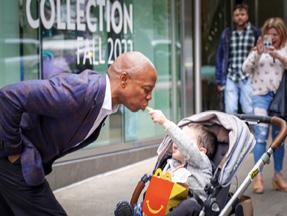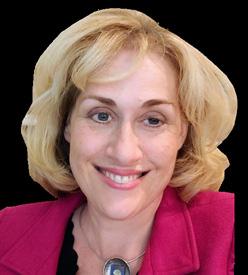
10 minute read
FIRST READ
After flooding concerns at the prior location, New York City changed course and chose Randall’s Island, which also has a flood risk, as the new site to house migrants.
MIGRANT TENT SHELTER RELOCATED
Advertisement
Even as New York City officials continue to receive criticism for their plan to house asylum-seekers in tents, Mayor Eric Adams announced that the location of those tent shelters will move from Orchard Beach in the Bronx to Randall’s Island between northern Manhattan, Queens and the Bronx. The move came amid concerns over flooding at Orchard Beach. Although Adams initially said he would not move the tent city after the parking lot in question did flood with several inches of rainwater, he quickly changed course. But the new site on Randall’s Island still has the risk of flooding even as the Adams administration

FRY BURGLAR
Despite our reputation for gruffness, New Yorkers will give a stranger the clothes off their back. Or, in New York City Mayor Eric Adams’ case, the fry out of their Happy Meal. While pounding the pavement on Oct. 2, Adams received the totally aboveboard gift from an infant constituent, proving that despite his obsession with clean eating, the mayor is just as vulnerable to McDonald’s fries as the rest of us.
– New York City Council Member Marjorie Velázquez, announcing she’d now be supporting the Bruckner rezoning in her East Bronx district
– Metropolitan Transportation Authority Chair and CEO Janno Lieber, on the completion of the Long Island Rail Road third track project, via Newsday cited its lower risk compared to Orchard Beach. Not long after that, the mayor announced a state of emergency over the migrant crisis as the city continued to struggle to house the nearly 20,000 asylum-seekers who had recently come to New York.
NEW YORK CITY REDISTRICTING MOVES AHEAD
Just a few weeks ago, the commission tasked with coming up with and approving new City Council district lines before they get sent to the mayor and lawmakers voted to reject the proposed map. The commission finally approved a new set of district lines, the third version of the proposal since July. The vote means that the City Council now has the opportunity to either approve or reject the proposed lines themselves before Adams receives the map for the final say. Despite the surprise rejection several weeks ago, the new map the commission has passed along only contains minor tweaks compared to the previous version.
FAMILY OF DANIEL PRUDE REACH SETTLEMENT WITH ROCHESTER
Two years following the death of Daniel Prude at the hands of Rochester police, his family has reached a $12 million settlement with the city. Although the city of Rochester does
not accept any liability for Prude’s death, the settlement closes the books on the police killing that rocked the upstate city when evidence of a police cover-up emerged. In 2020, police responded to calls about Prude, who was suffering from a mental health crisis at the time. They pinned him to the ground and covered his head with a hood. A medical examiner ruled his death a homicide with the cause of death complications from asphyxiation. Police initially suggested a drug overdose led to Prude’s death, and it took five months for details surrounding the deadly police encounter to emerge.
MAJOR UPSTATE JOBS INITIATIVES ANNOUNCED
President Joe Biden made a trip to the Hudson Valley to announce a $20 billion investment from IBM into its manufacturing plants in Poughkeepsie and surrounding areas. Once a major manufacturing hub, years of disinvestment have left Hudson Valley communities economically struggling. IBM’s new commitment promises to bring many of those lost jobs back to the region. Earlier in the week, U.S. Senate Majority Leader Chuck Schumer announced a $100 billion Micron Technology microchip factory just outside of Syracuse, another significant new source of manufacturing jobs, this time in Central New York, to spur economic development in parts of the state that have suffered from loss of such jobs in recent decades.

President Joe Biden announced a $20 billion IBM investment during his trip to the Hudson Valley, which promises to bring jobs back to the region.
Federal judge dismantles new state gun restrictions
A federal judge overruled portions of New York’s law restricting who can carry a gun in public and where guns can be carried – marking a victory for gun rights advocates and a blow to Democratic state lawmakers who passed the legislation this summer.
U.S. District Court Judge Glenn Suddaby issued the order in response to a lawsuit filed by six New York members of Gun Owners of America. Gov. Kathy Hochul’s administration said the state plans to appeal. “While this decision leaves aspects of the law in place, it is deeply disappointing that the Judge wants to limit my ability to keep New Yorkers safe and to prevent more senseless gun violence. We are working with the Attorney General’s office to review the decision carefully and discuss next steps in an appeal,” Hochul said in a statement issued shortly after the ruling was made public.
The law, which took effect on Sept. 1, was passed in response to the U.S. Supreme Court’s June 23 determination that the state’s previous requirement that an applicant show “proper cause” to obtain a concealed carry permit introduced an unconstitutional degree of subjectivity into the licensing process.
The new ruling granted a temporary restraining order to the plaintiffs by barring licensing agencies from requiring permit applicants to submit a dossier of their social media history, along with four character references and contact information for people who live with the applicant. Suddaby also limited the list of sensitive locations where guns were prohibited under the state law, including Times Square, libraries, public parks, private businesses and mass transit. Suddaby specifically said that provision could remain in place for government buildings, schools, places of worship and at protests.
“Although historical analogues certainly exist prohibiting carrying firearms in specific places, no historical analogues have been provided prohibiting carrying firearms virtually everywhere, as the (Concealed Carry Improvement Act) does,” Suddaby wrote in the 53-page ruling.
Suddaby’s order followed a ruling he issued in September that cast doubt on the constitutionality of numerous aspects of the law. The social media provision could potentially violate the First and Fifth Amendments, he wrote, and the legislation still gave licensing officers “open-ended discretion” to determine who could obtain a permit. – Sara Dorn
THE WEEK AHEAD
THURSDAY 10/13
The New York City Council plans to vote on a bill that would require the city to create a master plan for the city’s greenways, at 10 a.m. at City Hall. INSIDE DOPE
The bill would require multiple city agencies coordinate on a plan for paths like the Hudson River Greenway in Manhattan. THURSDAY 10/13
City & State hosts the Government Procurement Conference, featuring panelists from the state Senate and the New York City Council, starting at 9 a.m. at the Museum of Jewish Heritage. FRIDAY 10/14
The state Senate Corporations, Authorities & Commissions Committee and the Transportation Committee hold a hearing at 10 a.m. at 250 Broadway on the JFK Airport redevelopment.
GETTING STACKS DEPOSITED
New York City Mayor Eric Adams’ highest-paid lieutenants are scrambling to climb the org chart.

By Annie McDonough
Ingrid Lewis-Martin has been one of Adams’ closest confidantes since his days in the state Senate, proving that loyalty really does pay off.
Jimmy Oddo earns more as chief of staff to the deputy mayor of operations than he did as Staten Island borough president and is one of the few Republicans in Adams' administration.
Longtime political consultant Tiffany Raspberry may be up for a promotion after chief of staff Frank Carone departs, but as is, she’s still one of Adams’ highest-paid advisers. When it comes to sussing out power and influence in City Hall, salary isn’t everything. (Bernard Adams’ $1 annual paycheck should be proof of that.) But money does, as they say, talk. And the office of New York City Mayor Eric Adams is chock-full of deputy mayors, senior advisers and high-level staffers all earning more than $200,000 a year.
Here’s a look at City Hall’s top earners – including one official raking in more than Adams’ own $258,000 salary.
LORRAINE GRILLO $275,000 MARIA TORRES-SPRINGER $251,982 ANNE WILLIAMS-ISOM $251,982 MEERA JOSHI $251,982 PHILIP BANKS $251,982 SHEENA WRIGHT $251,982 INGRID LEWIS-MARTIN $251,982 BRENDAN MCGUIRE $251,982 FRANK CARONE $251,982 MELANIE LA ROCCA $247,577 JESSICA KATZ $247,577 MATTHEW FRASER $247,577 FERNANDO CABRERA $227,786 JEFFREY RODUS $225,000 ANDREA DAVIS $220,000 NATHAN BLISS $211,150 JUSTIN MEYERS $211,150 JIMMY ODDO $211,150 MAXWELL YOUNG $211,150 DAWN MILLER $211,150 RYAN LYNCH $201,071 MADELINE LABADIE $201,000 MENASHE SHAPIRO $201,000 MOLLY SCHAEFFER $201,000 GLADYS MIRANDA $201,000 TIFFANY RASPBERRY $201,000 MIR BASHAR $201,000
The mayor’s second in command is also getting the largest paycheck in City Hall, but First Deputy Mayor Lorraine Grillo may be on her way out of office.
Deputy Mayor for Public Safety Philip Banks is not only making bank, but he’s also scoring frequent sit-downs with top NYPD brass – even if they sometimes exclude the police commissioner.
A heavy-hitter from Adams’ mayoral campaign, Menashe Shapiro used his top administration post to nix a set of New York City Council district lines.
A Q&A with incoming New York City Campaign Finance Board Executive Director
BETH ROTMAN


The New York City Campaign Finance Board takes a lot of flack – you’re dealing with hundreds of hundreds of politicians and their staffers and consultants. Why do you want this job? There’s no question that this is a really hard role to be in. But I see it as a public service. I had one of my mentors explain – who worked on one of the early mayoral campaigns – he said, ‘This is an impossible role, at the New York City Campaign Finance Board, because you have to be both a goodgovernment program and a regulatory agency. So that’s impossible.” And that is true, it is very difficult to simultaneously encourage (first-time) candidates into a program while also hand-holding them through maybe their first audit ever to ensure protection of the public fisc. We also add to it that we want to encourage people to vote for the first time ever and get the message out to 8 million New Yorkers. But if we don’t think big, then we’re not able to make the kinds of changes that our democracy deserves. And democracy is how we solve the kind of problems that are facing our country today. New York City deserves – and I believe already had – the best campaign finance board. But I can’t resist wanting to serve and ensure that the program stays incredibly strong, and I hope it gets even stronger.
New York City Council Speaker Adrienne Adams recently said she liked the idea of moving city primaries to even-numbered years in order to align them with state and federal elections. Do you agree? I’d have to study more some of the structural changes. I know that there are a lot of different structural changes that could bring out more
An advocacy campaign including City & State First Read provides a targeted way to reach decision makers in New York government and politics. Campaigns Include:
ADVOCACY MESSAGING OPEN-HOUSE PROMOTIONS NEW HIRE ANNOUNCEMENTS
Contact us at advertising@cityandstateny.com for advertising and sponsorship opportunities.
voters, one reason or another. I’d have to look at that a little bit more closely. I think that from our standpoint of working on the structural democracy issues, there’s already a lot that we can do without making those really sort of more difficult changes.
The city has strict donation limits – way lower than the state, lower than the federal limits. But super PACs can spend endlessly, and they do. Is there a way for New York City to dull the impact of super PACs? Or is this up to the U.S. Supreme Court? The best way to dull the impact of super PACs is by amplifying the voice of small donors, so to do more of what New York City is doing already. Unquestionably, Citizens United was a disastrous decision, and Buckley wasn’t helpful before that, and we have constitutional limitations on taking away some of those huge, huge spenders. (But) when you’re amplifying the voices of everyday New Yorkers, that is the best counterbalance to that. Because we’re already seeing a New York government that is more responsive to everyday New Yorkers. – Jeff Coltin






